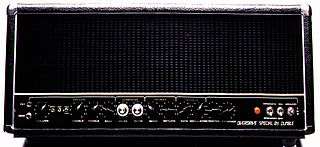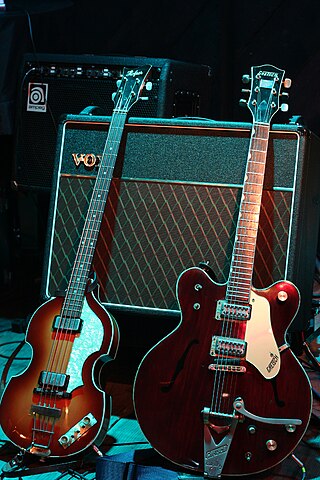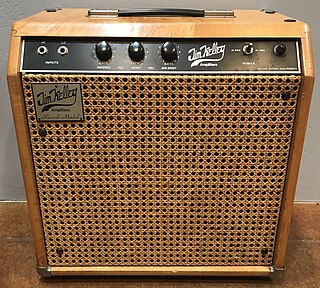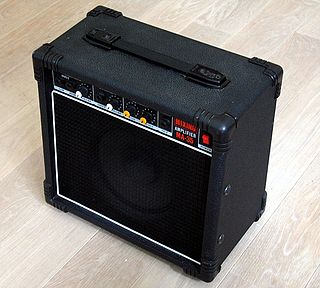
Vox is a British musical equipment manufacturer founded in 1957 by Thomas Walter Jennings in Dartford, Kent, England. The company is most famous for making the Vox AC30 guitar amplifier, used by The Beatles, The Rolling Stones, The Kinks, The Yardbirds, Queen, Dire Straits, U2, and Radiohead; the Vox Continental electric organ, the Vox wah-wah pedal used by Jimi Hendrix, and a series of innovative electric guitars and bass guitars. Since 1992, Vox has been owned by the Japanese electronics firm Korg.

A guitar amplifier is an electronic device or system that strengthens the electrical signal from a pickup on an electric guitar, bass guitar, or acoustic guitar so that it can produce sound through one or more loudspeakers, which are typically housed in a wooden cabinet. A guitar amplifier may be a standalone wood or metal cabinet that contains only the power amplifier circuits, requiring the use of a separate speaker cabinet–or it may be a "combo" amplifier, which contains both the amplifier and one or more speakers in a wooden cabinet. There is a wide range of sizes and power ratings for guitar amplifiers, from small, lightweight "practice amplifiers" with a single 6-inch speaker and a 10-watt amp to heavy combo amps with four 10-inch or four 12-inch speakers and a 100-watt amplifier, which are loud enough to use in a nightclub or bar performance.
Orange Music Electronic Company is an English amplifier manufacturing company, noted for their products' distinctive sound and the bright orange Tolex-like covering of their heads and speaker cabinets. The company was founded in 1968 by Cliff Cooper, who decided to build his own amplifiers when vendors refused to supply his West End musical instrument store, Orange Store, due to Cooper's youth and countercultural image. Cooper also founded related companies, including the Orange record label in 1969.

Marshall Amplification is a British company that designs and manufactures music amplifiers and speaker cabinets. Founded in London by shop owner and drummer Jim Marshall, the company is based in Bletchley, Milton Keynes, England. Since March 2023, Marshall Amplification has been one of several divisions of the Swedish conglomerate, the Marshall Group.

Mesa/Boogie is an American company in Petaluma, California, that manufactures amplifiers and other accessories for guitars and basses. It has been in operation since 1969.

Dumble was a guitar amplifier manufacturer in Los Angeles, California.

The Vox AC30 is a guitar amplifier manufactured by Vox. It was introduced in 1958 to meet the growing demand for louder amplifiers. Characterised by its "jangly" high-end sound it has become widely recognized by British musicians and others, such as George Harrison and John Lennon of the Beatles, Bill Wyman of the Rolling Stones, Brian May of Queen, Dave Davies of the Kinks and Hank Marvin.

The Fuzz Face is an effects pedal for electric guitar, used also by some electric bass players. It is designed to produce a distorted sound referred to as "fuzz", originally achieved through accident such as broken electrical components or damaged speakers.

The Fender Twin and Twin Reverb are guitar amplifiers made by Fender Musical Instruments Corporation. The Twin was introduced in 1952, two years before Fender began selling Stratocaster electric guitars. The amps are known for their characteristically clean tone.
Jennings Musical Instruments is a manufacturer of musical instruments, and the original owner of the Vox brand. The company was founded by Thomas Walter Jennings.

This is a history of the equipment that the English rock band The Who used. It also notes their influence on the instruments of the time period.

The Fender Bassman is a series of bass amplifiers introduced by Fender during 1952. Initially intended to amplify bass guitars, musicians used the 5B6 Bassman to amplify other instruments, including electric guitars, harmonicas, and pedal steel guitars. Besides being a popular and important amplifier in its own right, the Bassman also became the foundation on which Marshall and other companies built their high-gain tube amplifiers.

The Fender Super was a guitar amplifier made by Fender between 1947 and 1963 and, as the Super Reverb, until 1981. Though it was designed for a clean sound, its overdriven sound is praised by players and critics.
The Marshall Super Lead Model 1959 is a guitar amplifier head made by Marshall. One of the famous Marshall Plexis, it was introduced in 1965 and with its associated 4×12″ cabinets gave rise to the "Marshall stack".

The Mesa/Boogie Mark Series is a series of guitar amplifier made by Mesa Engineering. Originally just referred to as "Boogies", the product line took on the moniker "Mark Series" as newer revisions were put into production. The Mark Series amplifier was Mesa's flagship product until the introduction of the Rectifier series, and the amplifiers are collectable.
The Fender Deluxe guitar amplifier is a range of non-reverb guitar amplifiers produced by Fender. The amplifiers were originally produced from early 1948 to 1966 and reissues are in current production. Its predecessor was the Fender Model 26 "Woodie" produced from 1946 to 1948.

Jim Kelley Amplifiers is the trademark for the vacuum tube guitar amplifiers designed by Jim Kelley and manufactured by his company Active Guitar Electronics of Tustin, California between the years of 1978 and 1985. Approximately 600 of these amps were built during that time. The single-channel version of the amplifier employed modest gain in the preamp stages, Baxandall type bass and treble controls, a split load phase inverter, and four 6V6GT output tubes. The amplifiers produce 60 watts RMS at full power, and include a half power (30/60) switch.

The Marshall JTM45 amplifier is the first guitar amplifier produced by the British company Marshall. It was initially produced in 1963, and has been ranked among the most desirable of the company's amplifiers.

Traynor is a brand of bass amplifiers and guitar amplifiers, the first brand formed by Yorkville Sound. The Traynor brand, named for founder Peter Traynor, began in 1963 with the Dynabass bass amplifier, a rental product. Traynor first became popular in Canada by providing less expensive versions of the circuits used in Marshall and Fender amplifiers of the time. The revived brand now produces a wide range of electric, acoustic, and bass guitar amps.

A keyboard amplifier is a powered electronic amplifier and loudspeaker in a wooden speaker cabinet used for the amplification of electronic keyboard instruments. Keyboard amplifiers are distinct from other types of amplification systems such as guitar amplifiers due to the particular challenges associated with making keyboards sound louder on stage; namely, to provide solid low-frequency sound reproduction for the deep basslines that keyboards can play and crisp high-frequency sound for the high-register notes. Another difference between keyboard amplifiers and guitar/bass amplifiers is that keyboard amps are usually designed with a relatively flat frequency response and low distortion. In contrast, many guitar and bass amp designers purposely make their amplifiers modify the frequency response, typically to "roll-off" very high frequencies, and most rock and blues guitar amps, and since the 1980s and 1990s, even many bass amps are designed to add distortion or overdrive to the instrument tone.

















